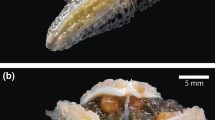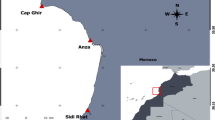Abstract
Seasonal fluctuations in environmental factors at high-latitude marine regions have a strong influence on the reproductive cycles of echinoderms. The purposes of this study on a population of Cosmasterias lurida in the Beagle Channel are to describe the reproductive cycle through histological analyses, to characterize the pattern of gonad and somatic indices, to determine the energy content of different organs and their temporal variation and to establish the pattern of energy allocation. During the study period, from August 2010 to June 2011, four seasonal samplings were performed in the subtidal zone of Ushuaia Bay. Indices (gonad, pyloric caeca and stomach), gonadal histology, organic matter and calorimetric measurements were determined. Gametogenesis begins in February and continues until June when oocyte size increases. The gonadal maximum development and gamete releasing take place between August and December. Temporal variation of energetic reserves in gonads occurs through the variation in gonad mass, with a GI major peak and energy content during August. Stomach and pyloric caeca show their maximum energy accumulation during June, while decrease of organic matter of the body wall takes place from August to December. The population of C. lurida from Beagle Channel suggests an annual reproductive cycle with two maturation events and the influence of water temperature on maturation and releasing of gametes. Different patterns of energy allocation to gonads between sexes were observed, with a greater energy investment in females than in males. Pyloric caeca, stomach and body wall were proposed as energy reservoirs for gonadal maturation and spawning.








Similar content being viewed by others
References
Adami ML, Gordillo S (1999) Structure and dynamics of the biota associated with Macrocystis pyrifera (Phaeophyta) from the Beagle Channel, Tierra del Fuego. Sci Mar 63(Suppl 1):183–191
Almandoz GO, Hernando MP, Ferreyra GA, Schloss IR, Ferrario ME (2011) Seasonal phytoplankton dynamics in extreme southern South America (Beagle Channel, Argentina). J Sea Res 66:47–57
Barker MF, Xu RA (1991) Seasonal changes in biochemical composition of body walls, gonads and pyloric caeca in two populations of Sclerasterias mollis (Echinodermata: Asteroidea) during the annual reproductive cycle. Mar Biol 109:27–34
Benítez-Villalobos F, Martínez-García M (2012) Reproductive biology of the starfish Pharia pyramidatus (Echinodermata: Asteroidea) from the Mexican tropical Pacific. J Mar Biol Assoc 92:1409–1418
Bos AR, Gumanao GS, Alipoyo JCE, Cardona LT (2008) Population dynamics, reproduction and growth of the Indo-Pacific horned starfish, Protoreaster nodosus (Echinodermata: Asteroidea). Mar Biol 156:55–63
Bouland C, Jangoux M (1988) Investigation of the gonadal cycle of the asteroid Asterias rubens under static condition. In: Burke RD, Mladenov PV, Lambert P, Parsley RL (eds) Echinoderm biology. Balkema, Rotterdam, pp 169–175
Boy CC, Pérez AF, Fernández DA, Calvo J, Morriconi ER (2009) Energy content variation in relation to reproduction of the puyen, Galaxias maculatus, in the southernmost limit of their distributional range (Tierra del Fuego, South America). Polar Biol 32:9–14
Brody S (1945) Bioenergetics and growth. Reinhold Publishing, New York
Byrne M (1992) Reproduction of sympatric populations of Patiriella gunni, P. calcari and P. exigua in New South Wales, asterinid seastars with direct development. Mar Biol 114:297–316
Byrne M, Morrice MG, Wolf B (1997) Introduction of the northern Pacific asteroid Asterias amurensis to Tasmania: reproduction and current distribution. Mar Biol 127:673–685
Calow P (1984) Economics of ontogeny—adaptational aspects. In: Shorrocks B (ed) Evolutionary ecology. Blackwell Scientific Publications, Oxford, pp 81–104
Carey C (1999) Energetics of reproduction. In: Knobil E, Neill JD (eds) Encyclopedia of reproduction, vol 1. Academic Press, San Diego, pp 1085–1091
Carvalho ALPS, Ventura CRR (2002) The reproductive cycle of Asterina stellifera (Mobius) (Echinodermata: Asteroidea) in the Cabo Frio region, southeastern Brazil. Mar Biol 141:947–954. doi:10.1007/s00227-002-088l-y
Castilla JC, Paine RT (1987) Predation and community organization on eastern Pacific, temperate zone, rocky intertidal shores. Rev Chil Hist Nat 60:131–151
Chia FS, Walker CW (1991) Echinodermata: Asteroidea. In: Giese AC, Pearse JS, Pearse VB (eds) Reproduction of marine invertebrates: VI. Echinoderms and lophophorates. Boxwood Press, California, pp 301–331
Clark A, Downey M (1992) Starfishes of the Atlantic. Chapmanand Hall, New York
Clarke A (1987) Temperature, latitude and reproductive effort. Mar Ecol Prog Ser 38:89–99
Coe WR (1943) Sexual differentiation in mollusks. I. Pelecypods. Q Rev Biol 18:154–164
Giese AC (1966) On the biochemical constitution of some echinoderms. In: Boolootian RA (ed) Physiology of echinodermata. Interscience, New York, pp 757–796
Giese AC (1976) Physiology of the echinoderm body wall. Thalass Jugosl 12:153–163
Gordillo S, Archuby F (2012) Predation by drilling gastropods and asteroids upon mussels in rocky shallow shores of southernmost South America: paleontological implications. Acta Palaeontol Pol 57(3):633–646
Grange LJ, Tyler PA, Lloyd SP (2007) Multi-year observations on the gametogenic ecology of the Antarctic seastar Odontaster validus. Mar Biol 153:15–23
Hernández DA, Tablado A (1985) Asteroidea de Puerto Deseado (Santa Cruz, Argentina). Contribución N°104. Centro Nacional Patagónico, Argentina
Hyman LH (1955) The invertebrates: echinodermata, the coelomate bilateria. McGraw Hill, New York, p 763
Lawrence JM (1987a) A functional biology of echinoderms. Croom Helm, London
Lawrence JM (1987b) Echinoderms. In: Pandian TJ, Vernberg FJ (eds) Animal energetics, vol 2. Academic Press, San Diego, pp 229–321
Lawrence JM, Ellwood A (1991) Simultaneous allocation of resources to arm regeneration and to somalie and gonadal production in Luidia clathrata (Say) (Echinoderrnata: Asteroidea). In: Yanagisawa T et al (eds) Biology of echinodermata. A.A. Balkema, Rotterdam, pp 543–548
Lawrence JM, Lane P (1982) The utilization of nutrients by post-metamorphic echinoderms. In: Jangoux M, Lawrence JM (eds) Echinoderm nutrition. A.A. Balkema, Rotterdam, pp 331–372
Lawrence JM, McClintock JB (1994) Energy acquisition and allocation by echinoderms (Echinodermata) in polar seas: adaptations for success? In: David B, Guille A, Féral J-P, Roux M (eds) Echinodermata. Balkema, Rotterdam, pp 39–52
Lucas A (1996) Energetics of aquatic animals. Taylor and Francis, London
Mackie GL (1984) Bivalves. In: Ompa AS, Verdonk NH, Van den Bigeelar JAM (eds) The Mollusca. Academic Press, New York, pp 351–418
Maier MS, Roccatagliata A, Seldes AM (1993) Two novel steroidal glycoside sulfates from the starfish Cosmasterias lurida. J Nat Prod 56(6):939–942
Maier MS, Kuriss A, Seldes AM (1998) Isolation and structure of glucosylceramides from the starfish Cosmasterias lurida. Lipids 33(8):825–827
Mariante FLF, Lemos GB, Eutrópio FJ, Castro RRL, Gomes LS (2010) Reproductive biology in the starfish Echinaster (Othilia) guyanensis (Echinodermata: Asteroidea) in southeastern Brazil. Zoologia 27(6):897–901. doi:10.1590/S1984-46702010000600010
McClintock JB (1989) Energetic composition, reproductive output, and resource allocation of antarctic asteroids. Polar Biol 9:147–153
McClintock JB, Pearse JS (1987) Biochemical composition of antarctic echinoderms. Comp Biochem Phys B 86:683–687
McEuen FS (1987) Phylum echinodermata, Class Holothuroidea. In: Sthratmann FM (ed) Reproduction and development of marine invertebrates of the northern Pacific coast. University of Washington Press, Seattle, pp 574–596
Miller SR, Lawrence JM (1999) Gonad and pyloric caeca production in the nine-armed starfish Luidia senegalensis of the southwest Florida gulf coast during the annual reproductive cycle. Bull Mar Sci 65(1):175–184
O’Neill PL (1994) The effect of anesthesia on spontaneous contraction of the body wall musculature in the asteroid Coscinasterias calamaria. Mar Behav Physiol 24:137–150
Pain SL, Tyler PA, Gage JD (1982) The reproductive biology of the deep-sea asteroids Benthopecten simplex (Perrier), Pectinaster filholi Perrier, and Pontaster tenuispinus Dubenand Koren (Phanerozonia: Benthopectinidae) from the Rockall Trough. J Exp Mar Biol Ecol 65:195–211
Pastor-de-Ward CT, Rubilar T, Díaz-de-Vivar ME, Gonzalez-Pisani X, Zarate E, Kroeck M, Morsan E (2007) Reproductive biology of Cosmasterias lurida (Echinodermata: Asteroidea) an anthropogenically influenced substratum from Golfo Nuevo, Northern Patagonia (Argentina). Mar Biol 151:205–217
Pearse JS (1965) Reproductive periodicities in several contrasting populations of Odontaster validus Koehler, a common Antarctic asteroid. Antarct Res Ser 5:39–85
Pearse JS, Bosch I (2002) Photoperiodic regulation of gametogenesis in the Antarctic sea star Odontaster validus Koehler: evidence for a circannual rhythm modulated by light. Invertebr Repr Dev 4(1–3):73–81
Pearse JS, Eernisse DJ (1982) Photoperiodic regulation of gametogenesis and gonadal growth in the sea star Pisaster ochraceus. Mar Biol 67:121–125
Pearse JS, Eernisse DJ, Pearse VB, Beauchamp KA (1986) Photoperiodic regulation of gametogenesis in sea stars, with evidence of an annual calendar independent of fixed daylength. Am Zool 26:417–431
Pérez AF (2009) Reproducción, energética y metabolismo oxidativo del erizo comestible Loxechinus albus en el Canal Beagle, extremo sur de su distribución. Facultad de Ciencias Exactas y Naturales Departamento de Ecología, Genética y Evolución, Universidad de Buenos Aires, Buenos Aires, p 245
Pérez AF, Morriconi E, Boy C, Calvo J (2008) Energetic variation of the sea urchin Loxechinus albus at the southernmost limit of their distribution range (Beagle Channel, Tierra del Fuego). Polar Biol 31:443–449
Pérez AF, Boy C, Morriconi E, Calvo J (2010) Reproductive cycle and reproductive output of the sea urchin Loxechinus albus (Echinodermata: Echinoidea) from Beagle Channel, Tierra del Fuego, Argentina. Polar Biol 33:271–280
Raymond JF, Himmelman JH, Guderley HE (2007) Biochemical content, energy composition and reproductive effort in the broadcasting sea star Asterias vulgaris over the spawning period. J Exp Mar Biol Ecol 341:32–44
Roccatagliata AJ, Maier MS, Seldes AM, Iorizzi M, Minale L (1994) Starfish saponins, part 2. Steroidal oligoglycosides from the starfish Cosmasterias lurida. J Nat Prod 57(6):747–754
Sastry AN (1970) Reproductive physiological variation in latitudinally separated populations of the bay scallop, Aequipecten irradians Lamarck. Biol Bull 138:56–65
Scheibling RE (1981) The annual reproductive cycle of Oreaster reticulatus (L.) (Echinodermata: Asteroidea) and interpopulation differences in reproductive capacity. J Exp Mar Biol Ecol 54:39–54
Seldes AM, Gros E (1985) Main sterols from the starfish Cosmasterias lurida. Comp Biochem Physiol 80B(2):337
Sokal RR, Rohlf FJ (1995) Biometry: the principles and practice of statistics in biological research. WH Freeman and Company, New York
Stanwell-Smith D (1997) Larval ecology of benthic marine invertebrates at Signy Island, Antarctica. PhD thesis, The Open University
Stanwell-Smith D, Clarke A (1998) Seasonality of reproduction in the cushion star Odontaster validus at Signy Island, Antarctica. Mar Biol 131:479–487
Strathmann RR (1985) Feeding and nonfeeding larval development and life-history evolution in marine invertebrates. Annu Rev Ecol Syst 16:339–361
Tyler PA, Pain SL, Gage JD (1982) The reproductive biology of the deep-sea asteroid Bathybiaster vexillifer. J Mar Biol Assoc UK 62:57–69. doi:10.1017/S0025315400020105
Vasquez JA, Castilla JC (1984) Some aspects of the biology and trophic range of Cosmasterias lurida (Asteroidea, Asteriidae) in belts of Macrocystis pyrifera at Puerto Toro, Chile. Med Ambient (Chile) 7:47–51
Xu RA, Barker MF (1990) Laboratory experiments on the effects of diet on the gonad and pyloric caeca indices and biochemical composition of tissues of the New Zealand starfish Sclerasterias mollis (Hutton) (Echinodermata: Asteroidea). J Exp Mar Biol Ecol 136:23–45
Zamora S, Stotz W (1992) Ciclo reproductivo de Loxechinus albus (Molina 1782) (Echinodermata: Echinoidea) en Punta Lagunillas, IV Región, Coquimbo, Chile. Rev Chil Hist Nat 65:121–133
Zar JH (1984) Biostatistical analysis. Prentice-Hall, New York
Acknowledgments
This research was supported by CONICET (PIP 0128). We would like to thank D. Aureliano and M. Gutiérrez for technical assistance, to J. Calcagno for statistical assistance, to D. Nahabedian, M. Brogger and A. Tablado for their generous advices.
Author information
Authors and Affiliations
Corresponding author
Rights and permissions
About this article
Cite this article
Cossi, P.F., Boy, C.C., Giménez, J. et al. Reproductive biology and energy allocation of the sea star Cosmasterias lurida (Echinodermata: Asteroidea) from the Beagle Channel, Tierra del Fuego, Argentina. Polar Biol 38, 1321–1333 (2015). https://doi.org/10.1007/s00300-015-1696-x
Received:
Revised:
Accepted:
Published:
Issue Date:
DOI: https://doi.org/10.1007/s00300-015-1696-x




